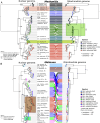Genomics of Neotropical biodiversity indicators: Two butterfly radiations with rampant chromosomal rearrangements and hybridization
- PMID: 40720651
- PMCID: PMC12337270
- DOI: 10.1073/pnas.2410939122
Genomics of Neotropical biodiversity indicators: Two butterfly radiations with rampant chromosomal rearrangements and hybridization
Abstract
A central question in evolutionary biology is what drives the diversification of lineages. Rapid, recent radiations are ideal systems for this question because they still show key morphological and ecological adaptations associated with speciation. While most research on recent radiations focuses on those occurring in insular environments, less attention has been given to continental radiations with complex species interactions. Here, we study the drivers of continental radiations of Melinaea and Mechanitis butterflies (Nymphalidae: Ithomiini), which have rapidly radiated in the continental Neotropics. They are classical models for Amazonian biogeography and color pattern mimicry and have been proposed as biodiversity indicators. We generated reference genomes for five species of each genus and whole-genome resequencing data of most species and subspecies covering a wide geographic range to assess phylogeographic relationships, hybridization patterns, and chromosomal rearrangements. Our data help resolve the classification of these taxonomically challenging butterflies and reveal very high diversification rates. We find rampant evidence of historical hybridization and putative hybrid species in both radiations, which may have facilitated their rapid diversification by enriching the genetic diversity. Moreover, we identified dozens of chromosomal fusions and fissions between congeneric species that have likely expedited reproductive isolation. We conclude that interactions between geography, hybridization and chromosomal rearrangements have contributed to these rapid radiations in the highly diverse Neotropical region. We hypothesize that rapid radiations may be spurred if repeated periods of geographic isolation are combined with lineage-specific rapid accumulation of incompatibilities, followed by secondary contact with some gene exchange.
Keywords: Neotropics; biodiversity; butterflies; genomics; speciation.
Conflict of interest statement
Competing interests statement:The authors declare no competing interest.
Figures




Similar articles
-
The Black Book of Psychotropic Dosing and Monitoring.Psychopharmacol Bull. 2024 Jul 8;54(3):8-59. Psychopharmacol Bull. 2024. PMID: 38993656 Free PMC article. Review.
-
Signs and symptoms to determine if a patient presenting in primary care or hospital outpatient settings has COVID-19.Cochrane Database Syst Rev. 2022 May 20;5(5):CD013665. doi: 10.1002/14651858.CD013665.pub3. Cochrane Database Syst Rev. 2022. PMID: 35593186 Free PMC article.
-
Sexual Harassment and Prevention Training.2024 Mar 29. In: StatPearls [Internet]. Treasure Island (FL): StatPearls Publishing; 2025 Jan–. 2024 Mar 29. In: StatPearls [Internet]. Treasure Island (FL): StatPearls Publishing; 2025 Jan–. PMID: 36508513 Free Books & Documents.
-
Fertility Cost (or Sometimes a Lack of It) in Relation to Heterozygosity for Robertsonian Rearrangements in Mammals: A Review.Cytogenet Genome Res. 2025 May 30:1-35. doi: 10.1159/000546385. Online ahead of print. Cytogenet Genome Res. 2025. PMID: 40451160 Free PMC article. Review.
-
Stigma Management Strategies of Autistic Social Media Users.Autism Adulthood. 2025 May 28;7(3):273-282. doi: 10.1089/aut.2023.0095. eCollection 2025 Jun. Autism Adulthood. 2025. PMID: 40539215
Cited by
-
Synergies between speciation and conservation science yield novel insights for mitigating the biodiversity crisis of the Anthropocene.Proc Natl Acad Sci U S A. 2025 Aug 5;122(31):e2500713122. doi: 10.1073/pnas.2500713122. Epub 2025 Jul 28. Proc Natl Acad Sci U S A. 2025. PMID: 40720642 Free PMC article. No abstract available.
References
-
- Losos J. B., Adaptive radiation, ecological opportunity, and evolutionary determinism. Am. Nat. 175, 623–639 (2010). - PubMed
-
- Gittenberger E., Radiation and adaptation, evolutionary biology and semantics. Organ. Divers. Evol. 4, 135–136 (2004).
-
- Czekanski-Moir J. E., Rundell R. J., The ecology of nonecological speciation and nonadaptive radiations. Trends Ecol. Evol. 34, 400–415 (2019). - PubMed
MeSH terms
Grants and funding
LinkOut - more resources
Full Text Sources

